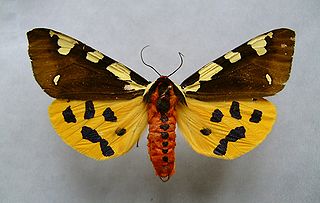
Plebejus is a genus of butterflies in the family Lycaenidae. Its species are found in the Palearctic and Nearctic realms.

Boloria is a brush-footed butterfly (Nymphalidae) genus. Clossiana is usually included with it nowadays, though some authors still consider it distinct and it seems to warrant recognition as a subgenus at least.
Amurrhyparia is a monotypic tiger moth genus in the family Erebidae erected by Vladimir Viktorovitch Dubatolov in 1985. Its only species, Amurhyparia leopardina, was first described by Embrik Strand in 1919. It is found in Russia and China.

Chelis is a genus of tiger moths in the family Erebidae. There are more than 30 described species in Chelis, found in the holarctic.

Panthea coenobita is a species of moth of the family Noctuidae. It is found in North Europe, East Europe and Southern Europe, the central and northern European part of Russia, Japan, Korea, northern China, the Russian Far East, southern and western Siberia and Turkey.

Miltochrista miniata, the rosy footman, is a moth of the family Erebidae. The species was first described by Johann Reinhold Forster in 1771. It is found in the temperate parts of the Palearctic realm – Europe, Asia Minor, Caucasus, northern Kazakhstan, southern Siberia, Amur, Primorye, Sakhalin, southern Kuriles, Heilongjiang, Liaoning, Hebei, Inner Mongolia, Shanxi, Sichuan, Korea and Japan, but may be replaced by Miltochrista rosaria in the eastern Palearctic.

Arctia is species of tiger moth in the family Erebidae. It was first described by Carl Linnaeus in his 1758 10th edition of Systema Naturae. It can be found in central and eastern Europe, Kazakhstan, southern Siberia, northern Mongolia, Amur Region, Primorye, Sakhalin, Kunashir, northern and northeastern China, Korea and Japan.
Solitanea is a genus of moths in the family Geometridae erected by Alexander Michailovitsch Djakonov in 1924.

Simyra splendida is a moth of the family Noctuidae. It is found in central Asia, from China to Tibet, Mongolia, the Korean Peninsula, the Russian Far East, southern Kazakhstan and southern Siberia (Transbaikalia).
Acronicta bellula is a moth of the family Noctuidae. It is found in the Korean Peninsula, northern China, north-eastern Mongolia, the Russian Far East and southern Transbaikalia.

Nycteola degenerana, the sallow nycteoline, is a moth of the family Nolidae. The species was first described by Jacob Hübner in 1799. It is found in Europe, from southern Fennoscandia to Spain, Italy and the Balkans. Outside of Europe it is found in China, Japan, the Korean Peninsula, the Russian Far East, southern Siberia, Turkey and the Ural.
Dolgoma cribrata is a moth of the family Erebidae first described by Otto Staudinger in 1887. It is found in eastern Asia, more specifically Russia, China, Korea and Japan.
Apantesis obliterata is a moth of the family Erebidae. It was described by Richard Harper Stretch in 1885. It is found in Russia, Mongolia and North America. The habitat consists of grasslands.
Pelosia angusta is a moth of the family Erebidae. It was described by Otto Staudinger in 1887. It is found in the Russian Far East and Japan.
Arctia ornata is a moth in the family Erebidae. It was described by Otto Staudinger in 1896. It is found in the Russian Far East and Mongolia.
Chelis buraetica is a moth in the family Erebidae. It was described by Otto Bang-Haas in 1927. It is found in Russia and Mongolia.
Spiris bipunctata is a moth in the family Erebidae. It was described by Otto Staudinger in 1892. It is found in Russia, central and eastern Mongolia and China.
Chelis dahurica is a moth in the family Erebidae. It was described by Jean Baptiste Boisduval in 1832. It is found in Russia and the Mongolian steppe.
Chelis ferghana is a moth in the family Erebidae. It was described by Otto Staudinger in 1887. It is found in Central Asia, Afghanistan and possibly Nepal.







